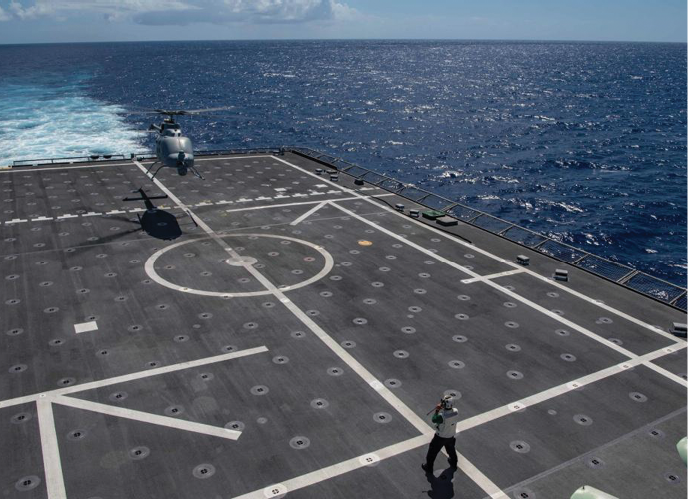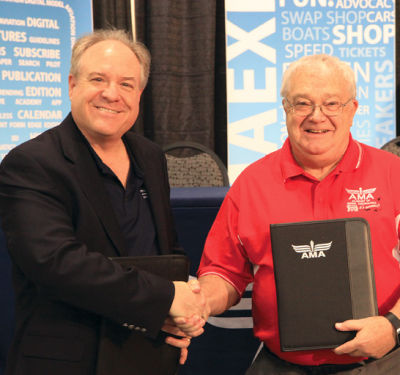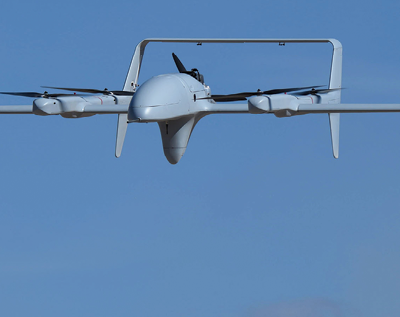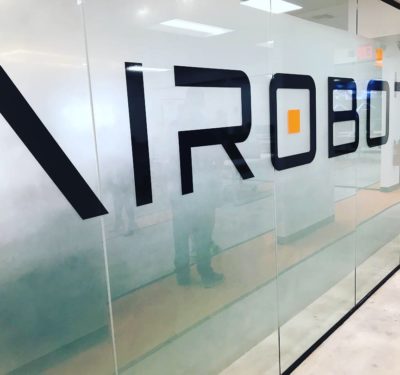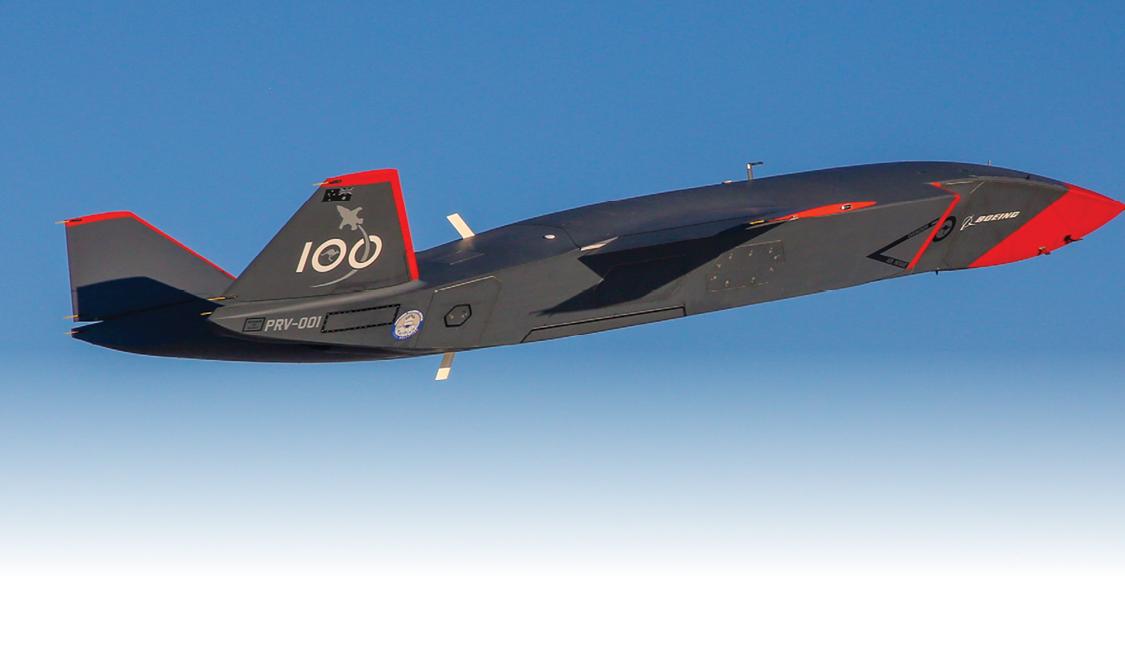
Manned-unmanned teaming, or MUM-T, capabilities are being developed for militaries through a variety of projects, with the goal of improving warfighter safety, lowering costs, and allowing both humans and machines to do what they do best.
As a warfighter flies into a contested environment, he sends the UAS flying with him out in front to not only provide critical situational awareness but to give him standoff distance as he assesses the situation. The enemy sees the UAS first, adding a layer of safety if he tries a counter-strike. Alternatively, multiple UAS are released from a surrogate aircraft and then fly in close formation, creating further confusion for the adversary and giving the pilot an advantage as he approaches.
Manned-unmanned teaming, or MUM-T, applications like these are gaining momentum in the defense space, as the capabilities they provide improve warfighter safety and allow humans and machines to do what they do best, making both more effective. Militaries and defense contractors are working to develop these capabilities through various programs, which include: the Air Force Research Lab’s (AFRL)Skyborg teaming architecture, DARPA’s Air Combat Evolution (ACE) Gremlins and LongShot programs, and Australia’s Loyal Wingman produced by its air force and Boeing Australia. The goal is to create affordable autonomous collaborative platforms that are attritable. If one of these systems is shot down, for example, not only is there no life lost, but the cost to replace the UAS is significantly less than, say, a fighter jet.
Over the last few years, the focus on MUM-T has shifted from basic capabilities to more specific applications that involve multiple systems, said Steve Fendley, Kratos Unmanned Systems Division (KUSD) president. Secretary of the Air Force Frank Kendall, Fendley noted, has set out the vision of aircraft like the B-21 flying with as many as four or five loyal wingmen, not just one. Because the programs are moving beyond the basics and are getting closer to becoming operational systems, many have gone from unclassified to classified.
Teaming will be used across domains, with unmanned assets also working together to improve operational efficiencies, said Wayne Prender, Textron senior vice president, air systems. The company recently demonstrated small-UAS-to-ground-vehicle unmanned teaming at the U.S. Army’s CyberQuest, using a mesh network to link them.
“Eventually, there will be multiple UAS and multiple ground vehicles working collaboratively together,” Prender said. “Now, it’s about fleshing out the TTPs [tactics, techniques and procedures] and concepts of operation, and gaining trust in the platforms to do some of these mission sets.”
The number of military applications where UAS can be deployed continues to increase, with Prender describing what MUM-T can allow as a game changer.
“It’s really picking up momentum in the industry,” Fendley said. “Kendall’s statement that we’re trending toward a scenario where there will be five UAS for every manned system in the air is incredibly significant. There’s a broad spectrum of solutions that are needed to make that happen.”

APPLICATIONS
UAS are flexible across a range of applications, said C. Mark Brinkley, spokesman for General Atomics Aeronautical Systems, from the compete phase to conflict and re-compete as necessary. At General Atomics, the focus is on developing Detect, Identify, Locate and Report (DILR) for historical as well as new missions, in contested environments where larger sensor and effect ranges are required.
Drones bring significant endurance, said Richard Sullivan, vice president of future programs at Northrop Grumman, providing an “unblinking stare” that can evaluate an area and identify what’s normal and what’s out of the ordinary based on months, years or minutes of history, and then provide signals back to the operator with pertinent information.
They also offer flexibility, he said, with the ability to adjust sensor placement in the air as needed. Northrop Grumman’s HALE platform offers 24 hours of persistence, for example, and can provide a secondary ability to communicate back to where the mission is being run. It also can be repositioned if something is disabling its ability to communicate.
These systems can take on communication relays in contested environments, Fendley said, which could be anything from basic comms to sensitive targeting information. The company’s XQ-58 Valkyrie demonstrated this capability with the F-35 and F-22 aircraft a few years ago. The typical comms relay can be used in a safe environment, with the UAS taking over when that environment changes.
Adding multiple drones to a mission also expands the types and number of sensors warfighters can carry, Fendley said, further enhancing situational awareness. Let’s say, for example, 10 different sensor types provide full awareness of a threat space, but there’s only room for four on the manned aircraft. The unmanned aircraft can carry the others, giving operators knowledge of the total threat space and allowing them to better prepare to defend themselves—increasing survivability.
Weapons capability is another mission type that increases survivability of the manned aircraft, as well as effectiveness, Fendley said.
“The manned fighter is back in a safe area and can reach the loyal wingman unmanned system, which has a weapons system on it, and look at all the targeting information and then make a decision on whether to release the weapon,” he said. “That’s an incredible capability. The warfighter has a standoff position to keep him safe and a higher probability of success with respect to a particular threat.”
This method still provides proper human control over air effects and electronic warfare, said Col. Paul Calhoun, program manager for Gremlins and LongShot in DARPA’s Tactical Technology Office, as a human will always be in the loop to ensure responsible deployment.
It’s these types of applications that allow commanders to make what Lt. Col. Larry Ware from AFRL describes as more risk-tolerant decisions. The human factor and the possibility of losing an expensive asset are no longer part of the calculus to determine if and how a mission should be performed. With UAS handling the more dangerous tasks, commanders can consider taking on more risk when executing missions.
UAS are also low observable, Textron’s Prender said, and can be operated in riskier threat environments where militaries don’t want to be identified.
Human-machine collaborative dogfighting is another application being explored, and is the focus of DARPA ACE. Program performers are creating AI dogfighting agents by applying them to “missions of increasing difficulty and realism,” program manager Lt. Col. Ryan “Hal” Hefron said.
“In a future air domain contested by adversaries, a single human pilot can increase lethality by effectively orchestrating multiple autonomous unmanned platforms from within a manned aircraft,” he added. “This shifts the human role from single platform operator to mission commander. In particular, ACE aims to deliver a capability that enables a pilot to attend to a broader, more global air command mission while their aircraft and teamed unmanned systems are engaged in individual tactics.”
Shield AI is among the performers, company vice president Brett Darcey said, and is working on developing an AI pilot for 1-v-1, 1-v-2 and 2-v-1 dogfighting.
No matter the application, UAS will augment and support manned aircraft, never completely taking over. They’ll take on dangerous missions, providing ISR, identifying targets and even releasing weapons as told, with a human still overseeing and directing the systems on some level.
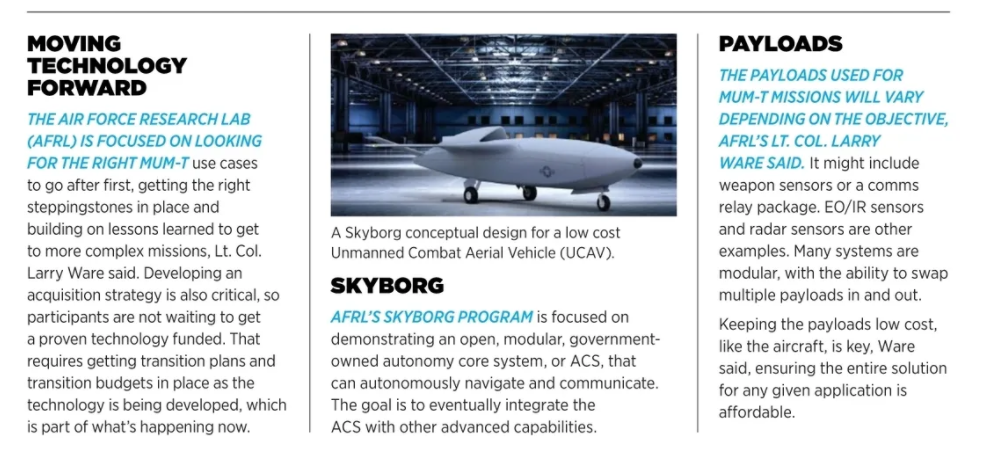
TECHNOLOGY DEVELOPMENT
The key to manned-unmanned teaming, AFRL’s Ware said, is having a good technology base that can be appropriately matured. AFRL works with users to identify capability gaps and then determine how they can make smart investments to fill them, whether within the network, the human-system interface or the aircraft itself. The key is to make the systems affordable.
Kratos, for example, builds UAS that are inexpensive to manufacture and repair, Fendley said, much like their target systems, which are meant to be shot down during training exercises. UAS tend to be at least 1/10th the cost of a manned asset, and, given current budget realities and multiple potential conflicts, that type of affordability is critical. The lower cost also makes mass and distributed capabilities possible.
Those are two critical components of DARPA’s Gremlins program. Gremlins is aiming to solve the problem of quantity. Right now, the cost for a large number of assets that can fly long ranges is too prohibitive. With this model, UAS are launched from existing large aircraft, such as bombers and fighters, and then captured after the mission and carried home, providing the critical combination of long range and low cost.
“If you’re up against an adversary in a single platform you have a single point of failure, making you somewhat vulnerable,” Calhoun said. “What we want to do is have multiple platforms that can create a more complicated scenario for an adversary. Having all these platforms available is absolutely necessary for manned-unmanned teaming efforts because you need the additional platforms to provide that capability. If the solution is always to build more UAS as large as the original, you can’t get there in terms of the quantity needed to overwhelm the adversary.”
The main technical challenge to this, Calhoun said, is safely and reliably performing air recovery, which the team was able to demonstrate last fall. During the test flight deployment, two X-61 Gremlin Air Vehicles validated all autonomous formation flying positions and safety features, with one successfully being recovered by a C-130. The recovered vehicle was refurbished and conducted a second flight 24 hours later. One vehicle was destroyed during the test.
Navigation to the recovery bullet, which hangs below the C-130, is difficult, Calhoun said, as the bullet moves as the aircraft is flying. The team developed a visual relative navigation solution to address this issue, with a video cache tracking and moving the Gremlin to where the bullet is.
When the Gremlin is far from the host, the blended GNSS/INS navigation solution recognizes where the Gremlin is in the world; closer in, it starts using the data link it has with the host to update its position. As it nears its target, a number of cameras, and AI, track the location of the bullet and predict its motion. That information is fed directly into the Gremlin’s flight control system.
Robust networks and data links are crucial to teaming, whether manned/unmanned or unmanned/unmanned, and is what Textron demonstrated at CyberQuest with a UAS and an unmanned ground vehicle.
The Textron team leveraged a variety of electronic warfare (EW) and SIGNAIT payloads to identify and locate emitting targets. Using time-of-light measurements and other techniques, it was able to geolocate targets and provide reference cues to the ground vehicle, which was then able to investigate or engage, depending on the scenario. These payloads, along with full motion video, mesh networks and radios all operated within an integrated tactical network that allowed the two platforms to work collaboratively.
“The EW and data link RF spectrum can be compromised,” Prender said, “and when that occurs, UAS can stay outside of that degraded bubble or have additional hardening to make them less susceptible to being jammed or spoofed or degraded. The air asset can provide target, location and navigation aids to assets on the ground or other assets in the air. It also can be used in maritime with UAS and unmanned surface vehicles.”
Often, ground assets are carrying equipment that emit, making them a target, Prender said. Offloading those emitters to ground robots creates further standoff distance, but also gives awareness to dismount unit connectivity through a tactile network.
For the dogfighting application being explored through DARPA ACE, the core technology required is advanced reinforcement learning techniques, Hefron said. These can be contrasted against supervised machine learning techniques that rely on large datasets to train behaviors.
The aircraft communicate through radio data links, Hefron said. Each aircraft will have a radio that allows it to transmit and receive from the other aircraft and the ground station.
Boeing’s Loyal Wingman, which will be deployed by the Royal Australian Air Force, leverages on-board autonomous command-and-control technology, tested both in the lab and in the field in Australia, said Glen Ferguson, director, Airpower Teaming System Global Program at Boeing. The design, development, manufacturing and test program have been made possible by Boeing’s adoption of digital engineering.
Boeing’s Airpower Teaming System (ATS), which was demonstrated late last year, is designed to take on a range of expeditionary missions and support distributed air operations. It will provide a “fighter-like flight performance,” Ferguson said, supporting both crewed and uncrewed assets to “complement and extend existing fleets.”
The aircraft’s modular nose, which can be missionized, allows for customization.
“The nose can be removed from the aircraft in the field, and the aircraft can be ready for a completely different mission in a short amount of time,” Ferguson said. “This flexibility gives control over the most important part of the aircraft, the missionization, which includes the systems, sensors and software that give it advanced operational capability.”
The U.S. Army is investing in tactile radios as well as longer-range of sight (LOS) radios for manned-unmanned teaming involving the GA-ASI Gray Eagle-Extended Range (GE-ER) UAS, Brinkley said. These radios will allow for longer-range, more survivable waveforms, as well as a more diverse set of lion and coalition assets. The Army is also incorporating a modular open systems approach (MOSA) onto the GE-ER, which supports advanced autonomy on the aircraft, “with the end state being simplified MUM-T operations and an ability to rapidly iterate capabilities.”
Communication and automation are both key to the GE-ER and manned-unmanned teaming in general. The system stays in synch with other ground and airborne efforts for reliable and secure communication to enable real-time collaboration. It also has in-process aircraft updates that make it possible to host automation and autonomy capabilities onboard the aircraft.
“This approach allows a total change in how MUM-T will be executed,” Brinkley said, “moving from traditional operations to ‘intent-based’ tasking of assets by manned aircraft.”
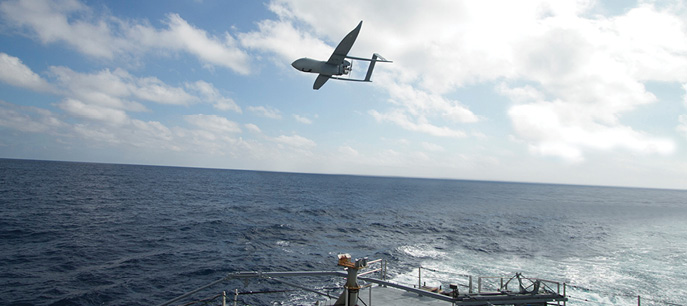

AI A CRUCIAL ELEMENT
As MUM-T capabilities are developed, AI is being leveraged to improve reliability and decrease maintainability, ultimately reducing solider burden as well as cost, Brinkley added. It’s also improving automation for more effective operations.
AI research has the ability to perform “at superhuman levels in applications of increasing complexity,” Hefron said, such as self-driving vehicles and gaming, and has reached a maturity level allowing it to transition to a live air combat environment with human-machine collaboration.
“AI is critical because it is capable of winning in the air combat environment,” Hefron said, “which is complex and rapidly evolving, putting it beyond the capabilities of simpler rules-based agents.”
Among the questions DARPA ACE poses to AI, Darcey said, is not only, “How do we build it out?” but “How do we trust it to perform complex maneuvers?” “How does a human actually work with it?” Shield AI is using virtual reality to help build that trust, allowing fighter pilots to sit in the cockpit with the AI-based wingmen flying around them in a 2-v-2 scenario, asking them to assess their trust in the system as it exists today as well as how well the AI performs.
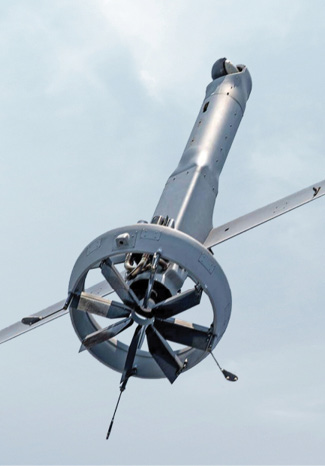
The team, which earned first place at DARPA’s AlphaDogfight Trials, is also investigating what the human-machine interface could look like to determine how the AI should communicate information with pilots so as not to overwhelm them, Darcey said.
“One of the main challenges is aligning human expectations with machine-generated tactics and vehicle control,” Hefron said. “This challenge is being overcome by involving pilots in the development of human-machine interfaces that account for the subtleties of a given AI agent’s behavior.”
Northrop Grumman uses AI to help systems operate within a given boundary and to make the best decision out of the multiple possible to stay within those bounds given the situation, Sullivan said. For example, before performing the first carrier takeoff and landing with its unmanned X-47B, the team used modeling and simulation to test the hundreds of thousands of scenarios possible on a U.S. Navy aircraft carrier sailing into the wind, with the deck moving up and down as the aircraft came in for a landing. AI looked at corner cases—what could happen at the same time, and what couldn’t—to understand how the vehicle would respond. From that testing, they developed the actual software flight programs.
AI is also used in threat recognition, Prender said. As the algorithms onboard the vehicles become better, they’ll not only be able to identify that there’s a tank, but what kind of tank it is and if it’s a threat, for example. The technology is also used for better positioning.
“When the air asset is trying to navigate and operate in the mesh network, AI optimizes its position to not only ensure it has the strongest signal strength so it can pass data that’s operationally relevant,” Prender said, “but also position itself where it can detect the EW threat as well as continue to localize where the friendly ground forces in this scenario are. All of that is done in an automated fashion on board the aircraft with no operator interface.”
Through AI, different levels of autonomy are possible, Fendley said. Leveraging simpler versions, aircraft can automatically perform a function without human commands. It can look at criteria and make a decision based on those criteria. For example, if the aircraft is flying and sees a mountain in front of it, it will climb until it doesn’t see it anymore and can safely fly through. That’s basic autonomy. When higher tech systems see a mountain, they’ll look for a gap between the mountain to go through, even though they’ve never done that before.
The goal, with all the technologies, is to reduce the interface the manned pilot has with the UAS to almost zero, except when approving weapon deployment, Fendley said.
“When AI is integrated into these systems, that capability increases and the workload on the manned pilot decreases,” he explained. “This is important for complex combat loyal wingman missions. They need to know exactly where the UAS are and why and what they’ll do.”
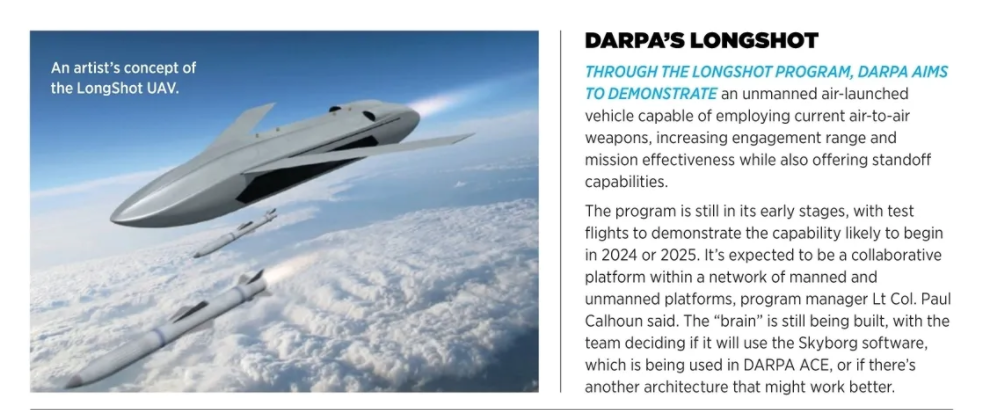
LOOKING AHEAD
There’s a “significant market” for loyal wingman capabilities that increase force mass to match or over-match future threats, Ferguson said. The goal is to make this more affordable with less risk to the manned systems and the pilots inside them.
Employing UAS to fly alongside manned aircraft allows both systems to do what they do best, improving efficiencies and saving costs, Sullivan said. This lengthens the life cycle of both vehicles. Different UAS such as the MQ-8C Fire Scout from Northrop Grumman will be deployed for specific jobs once taken on by manned systems, such as bomb damage assessment or ISR, providing the needed persistence and standoff distance for safety, while also saving the manned vehicles for other jobs.
MUM-T and manned-manned teaming will be used across domains, Prender said, with multiple systems in the air, ground and sea collaborating via mesh network.
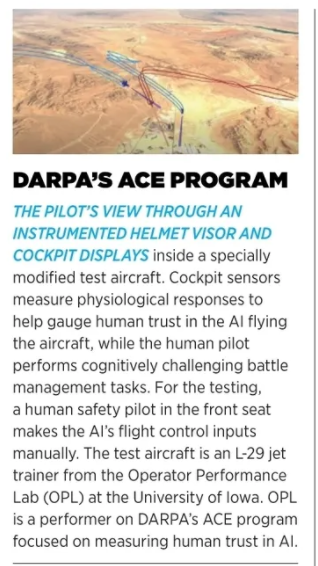
The AI algorithms will become more sophisticated, Calhoun said, and autonomy will be leveraged more to enhance human capabilities in the battle space. A new class of smaller platforms will be created, with the goal of allowing all systems to collaborate no matter which manufacture develops them. The number of UAS deployed alongside manned aircraft will continue to rise, augmenting their capabilities. Rather than only a few expensive platforms, which is limiting, there will be multiple more affordable, attritable platforms flying.
The mission possibilities will continue to become more complex, and the systems more affordable.
“There have been a lot of demos of the basic capabilities, and these tend to be one-offs,” Fendley said. “We’re going to start seeing more larger experimentation sets that are directly tied to some scenarios or programs of record that are looking at a system and are now going to buy and deploy it.”
As testing continues, Sullivan expects there to be an acceleration of acceptance and use in the defense space.
“The possibilities are endless,” Prender said. “As these demonstrations continue to open the eyes of the observers and Army experimenters, they will continue to come up with new tactics and procedures.”
